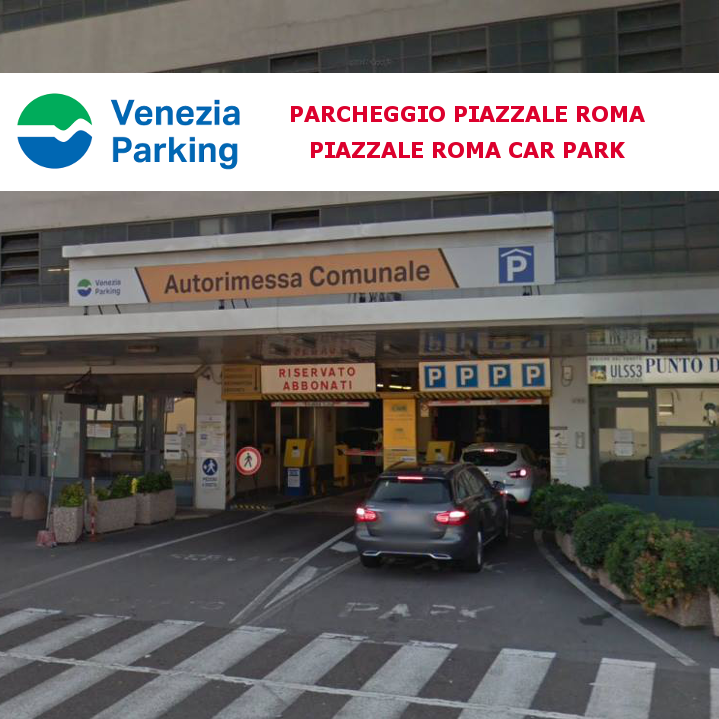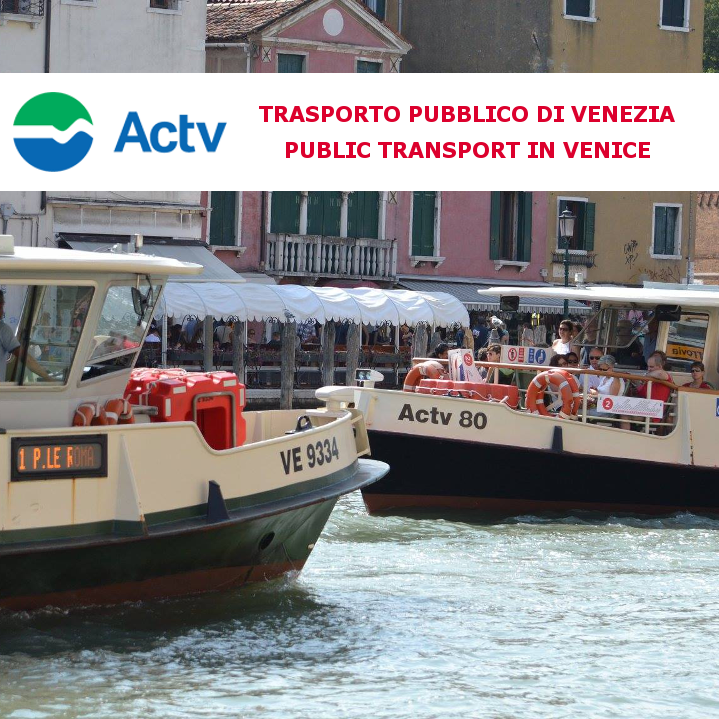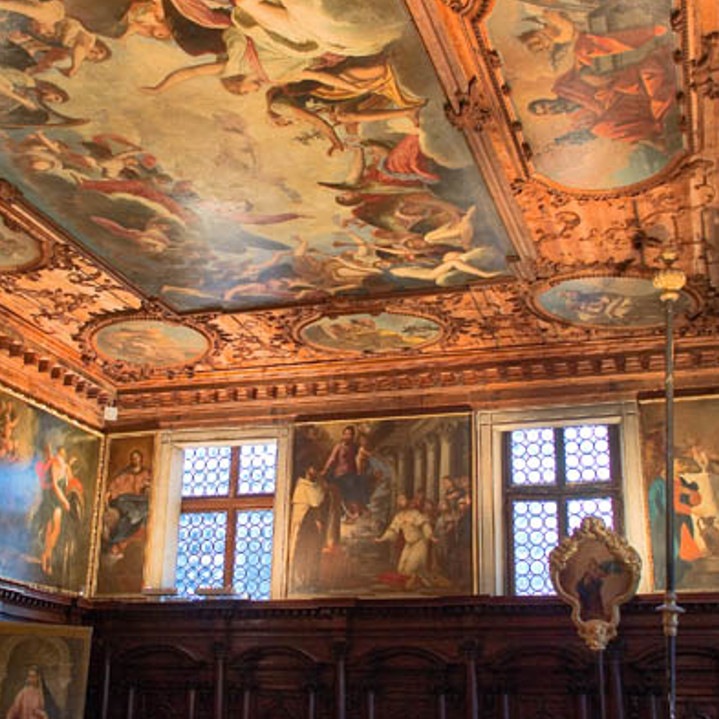You are here
Dorsoduro, art district: from Venetian origins to international contemporary art
Dorsoduro, art district: from Venetian origins to international contemporary art
This itinerary allows you to really get the feel of the Dorsoduro district, passing through Santa Croce and San Marco and exploring their most authentic areas. The origin of the name “de osso duro” (of hard bone) comes from the fact that the district was built on solid land, which was raised and less marshy than other districts of the city. Evidence of this name can be found in the inscription on the lion’s mouth on the lateral facade of the former Gesuati alle Zattere monastery.
The itinerary takes about three hours, which covers walking time and entry to the various churches that can be visited. If you wish, you can also add a visit to a museum or exhibition of your choice from those suggested. You can start the itinerary at any stage along the route, so it can vary in duration and distance to suit your requirements.
Back in 2017, the City of Venice launched the #EnjoyRespectVenezia awareness campaign to promote sustainable tourism. Please ensure that you always behave responsibly and respectfully towards the city, taking particular note of the following:
- Do not stop and stand on bridges
- Keep to the right
- Only purchase goods from authorised retailers
- Use licensed tour guides.
- Duration: 3 hours + 1 hour visit to a museum or exhibition of your choice
- Distance: 5 km
- Mode: On foot
- Suggested period: All year round
- Suitable for children: Yes
- Disabled access: Partial
- Departure: Piazzale Roma / Santa Lucia Station – Santa Croce district
- Arrival: Campo Santo Stefano – San Marco district
- Districts: Santa Croce - Dorsoduro - San Marco
- Links with other itineraries: “Monumental churches, synagogues and scuole grandi: a multicultural walk in Cannaregio”. Link from Campo Santo Stefano. “Beauty mirrored in the water: discovering Giudecca and San Giorgio Maggiore”. Link from the Church of Santa Maria dei Carmini or Fondamenta delle Zattere.
Itinerary details
- Departure: Piazzale Roma / Santa Lucia Station – Campo San Pantalon
- Stage 1: Church of San Pantalon – Bansky
- Stage 2: Campo Santa Margherita – Church of Santa Maria dei Carmini
- Stage 3: Church of Santa Maria dei Carmini - Ponte dei Pugni - Church of San Barnaba
- Stage 4: Campo San Barnaba - Squero di San Trovaso
- Stage 5: Fondamenta delle Zattere - Punta della Dogana
- Stage 6: Basilica of the Madonna della Salute - Peggy Guggenheim
- Stage 7: Peggy Guggenheim - Ponte dell’Accademia - Gallerie dell’Accademia
- Arrival: Campo Santo Stefano – Campo San Samuele - Gran Teatro La Fenice
-
Sources
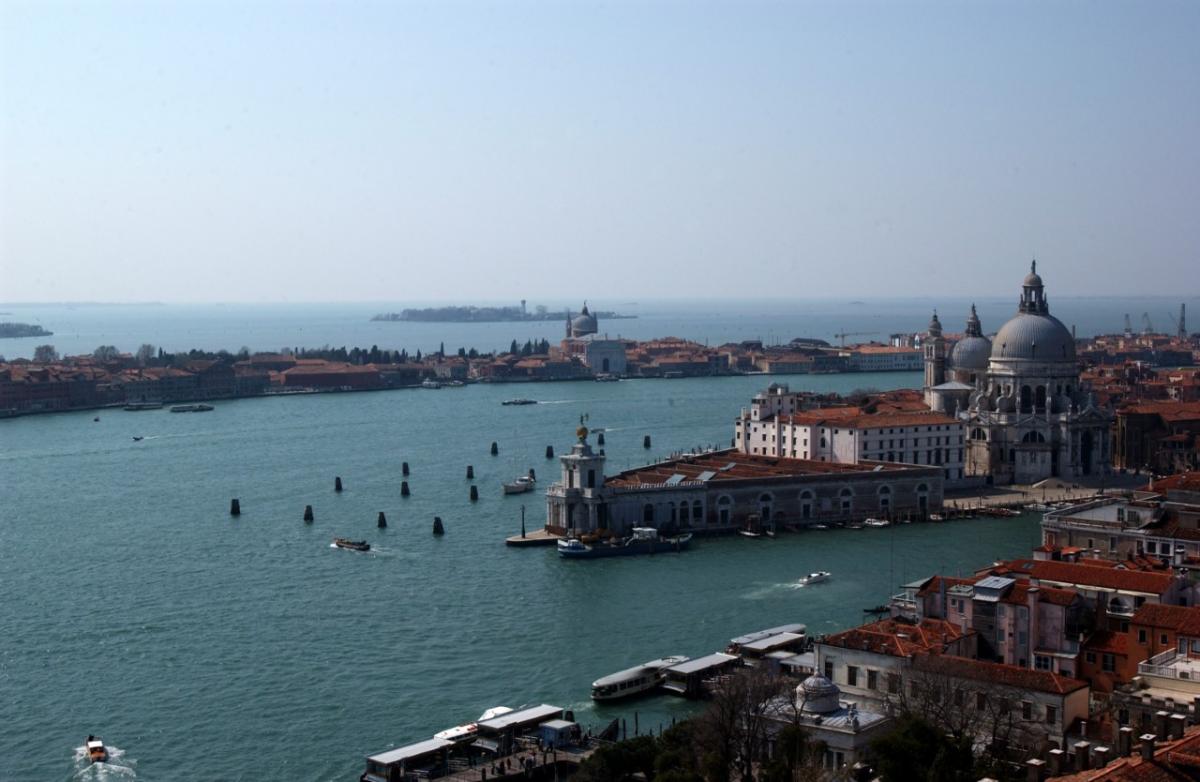
Punta della Dogana with the domes of the Basilica della Salute in the background
Departure: Piazzale Roma / Santa Lucia Station – Campo San Pantalon
The itinerary suggested begins or ends at Piazzale Roma or Santa Lucia Station, depending on which direction you take, bearing in mind that you can start it at any stage. It is worth noting the nearby Papadopoli gardens, a large green space where the Convento della Croce once stood.
From here, cross the Ponte dei Tolentini and turn right into Fondamenta dei Tolentini, where you will immediately encounter the Church of San Nicolò da Tolentino on the left, in the square of the same name. The church was designed and begun by Vincenzo Scamozzi and completed eleven years later, although the facade remains unfinished.
Go all the way along Fondamenta dei Tolentini and then turn left into Fondamenta Minotto. Now go straight on and take the fork on the right that leads to Campiello Mosca. Cross the bridge and you’ll find yourself in Campo San Pantalon, home to the church of the same name.
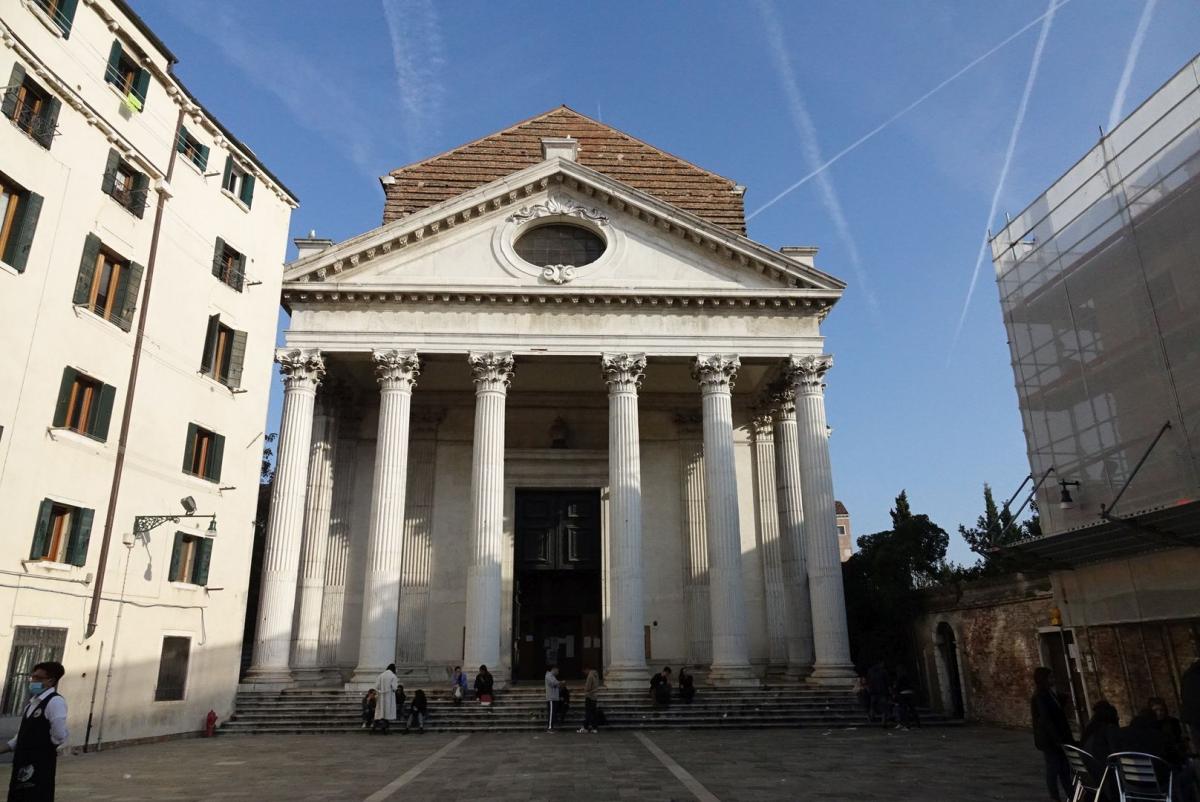
Campo dei Tolentini, overlooked by the Church of San Nicola da Tolentino, designed by Vincenzo Scamozzi
Stage 1: Church of San Pantalon – Banksy
The Church of San Pantalon has been rebuilt and redesigned several times over the years. The current structure dates back to 1704, although the main brick facade remains unfinished. It houses more than eighty valuable works, but what makes the church unique is its ceiling. What may appear at first glance to be a well-executed fresco is actually an oil painting produced between 1680 and 1704 on forty canvases, which were then joined together. It measures around 443 square metres in total and is by the Venetian painter Giovanni Antonio Fumiani, who specialised in stage sets. The painting depicts the Martyrdom and Glory of St Pantaleon, patron saint of midwives and co-patron saint of doctors together with Cosmas and Damian.
The martyrdom scene is on the left-hand side. In the centre is the celebration of the triumph of St Pantaleon, welcomed into Paradise by Christ and a multitude of angels, who present him with the crown of glory and the palm of martyrdom (to get a better view, we recommend standing at the entrance door and looking at the majestic painting from there). In the corners of the counter facade you can clearly see the four cardinal Virtues: Fortitude and Temperance (on the right), Justice and Prudence (on the left). Meanwhile, heading towards the chancel, there are depictions of the three theological Virtues: Hope leaning on an anchor, Faith with the chalice and Charity surrounded by children.
When you come out of the church, walk onto the bridge leading off Campo San Pantalon in the direction of Campo Santa Margherita. From here, look across the right-hand side of the bridge to the building facing the right-hand side of the canal, and, at water level, you will see a mural attributed to the famous street artist Banksy, whose identity remains a mystery. The work, entitled Migrant Child with a Flare, was created just a few days before the opening of the 2019 Venice Biennale of Contemporary Art.
Useful information:
- Church of San Pantalon: Monday to Saturday 10.00 a.m. – 12.30 p.m. and 3.30 p.m. –6.00 p.m. Sundays: 9.30 a.m. – 12.30 p.m. and 3.30 p.m. – 6.00 p.m. Closed on Fridays. Free entry. Check the website for any changes to the opening hours https://www.sanpantalon.it/
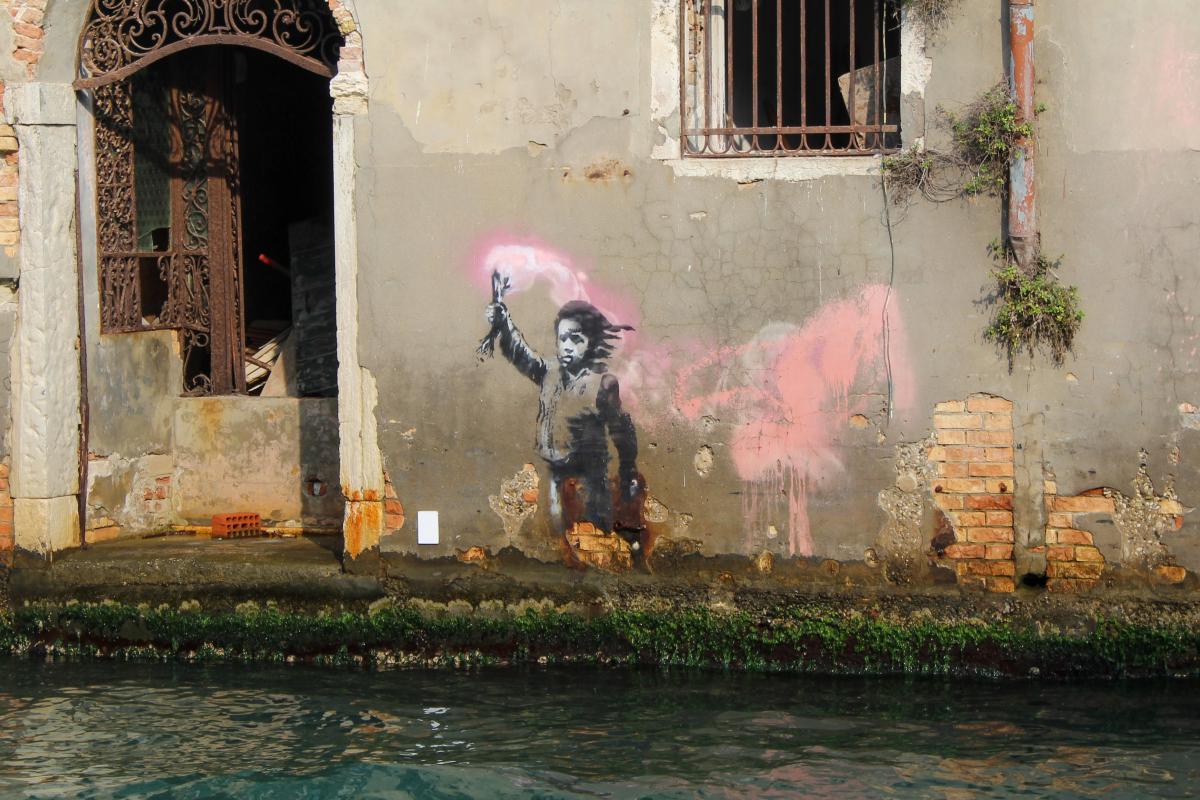
The mural attributed to Banksy
Stage 2: Campo Santa Margherita – Church of Santa Maria dei Carmini
Once you have seen the mural, the itinerary moves on to one of the liveliest places in Venice: Campo Santa Margherita. The square gets its name from the deconsecrated church that now houses the auditorium of the Ca' Foscari University. The church facade features a statue of St Margaret in a niche. Inside there is only one fresco to admire on the ceiling: the Martyrdom of St Margaret of Antioch, painted by Antonio Zanchi. One of the unique characteristics of this square is its bell tower, which was “cut down” in 1808 due to its instability. To demonstrate the importance of this square to the city’s social life over the centuries (thanks in part to the presence of an important market), it has churches at both ends (Santa Margherita and Santa Maria dei Carmini), while the buildings around it housed numerous Arts and Trade schools, including the School of the Varoteri (furriers). Furs were widely worn in Venice to protect against the cold, by all social classes.
To the south-west of Campo Santa Margherita is the Scuola Grande dei Carmini, the last of Venice’s scuole grandi, which were religious and charitable confraternities. The buildings have gone on to become monumental complexes rich in exceptional artistic treasures. The school was recognised as a “Scuola Grande” by the Council of Ten of the Venetian Republic in 1767. The brothers used to meet inside the building, in the Sala del Capitolo (chapterhouse), where Giambattista Tiepolo painted the nine canvases on the ceiling between 1739 and 1744, with the Virgin in Glory depicted in the centre.
Next to the school, in Campo dei Carmini, is the majestic Church of Santa Maria dei Carmini, also known as the Church of Santa Maria del Carmelo, built from the late thirteenth century onwards by the Carmelite Friars. The Gothic style has been maintained in its basilica-like structure and in the shape of the transept, while the church underwent numerous architectural changes over the following centuries, as is clearly visible in the Renaissance-inspired facade with its curvilinear trilobate pediment and in the rich sixteenth-to-eighteenth-century decorations inside. The church houses paintings by a number of artists, including Giovanni Battista Cima da Conegliano, Francesco di Giorgio Martini, Marco Vicentino, Palma il Giovane, Gaspare Diziani and Lorenzo Lotto.
From Campo dei Carmini you can join the “Beauty mirrored in the water: discovering Giudecca and San Giorgio Maggiore” itinerary.
Useful information:
- Scuola Grande dei Carmini: Saturday and Sunday 11.00 a.m. – 5 p.m. Full-price ticket €7. See the following link for concessions http://www.scuolagrandecarmini.it/
- Church of Santa Maria dei Carmini: Monday to Saturday 10.30 a.m. – 1.30 p.m. and 2.30 p.m. – 5.00 p.m. Admission €3. https://www.chorusvenezia.org/; http://www.scuolagrandecarmini.it/chiesa.php
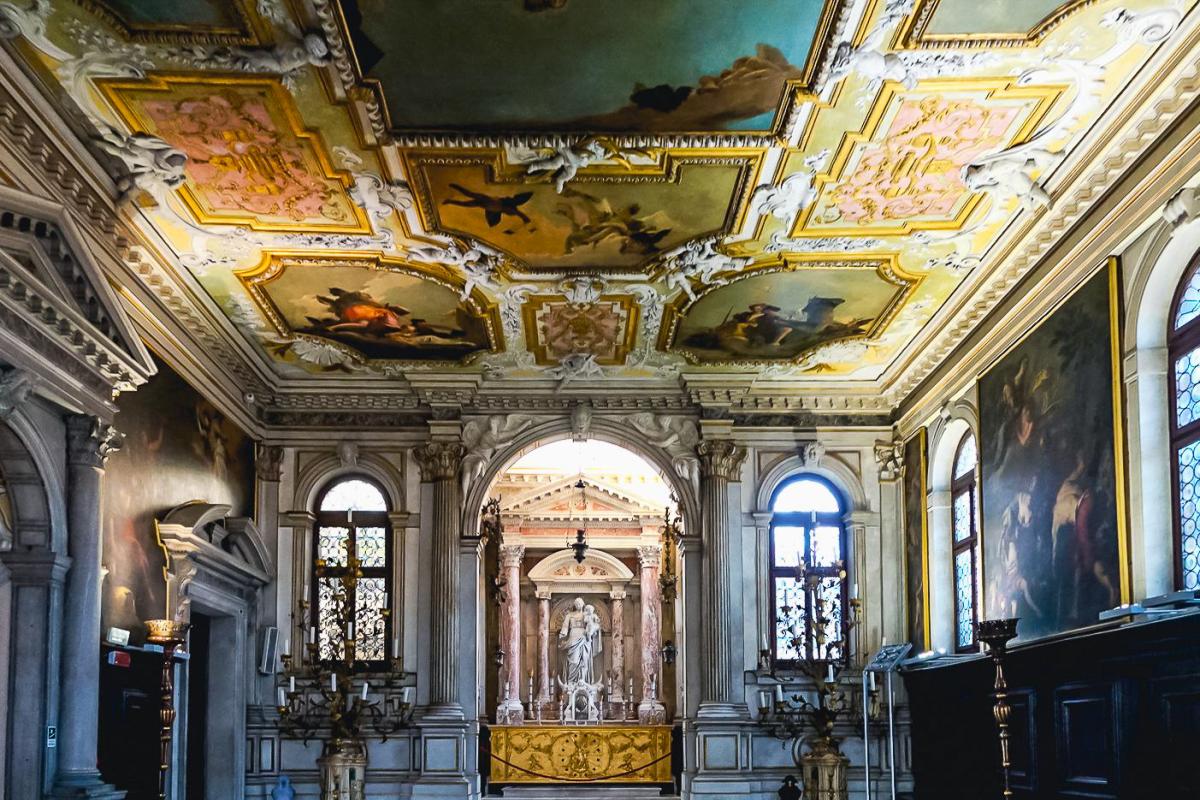
Scuola Grande dei Carmini, the last of the city’s scuole grandi
Stage 3: Church of Santa Maria dei Carmini - Ponte dei Pugni - Church of San Barnaba
Leaving the Church of Santa Maria dei Carmini behind, take the fork on the right that leads off Campo Santa Margherita towards Rio Terrà Canal, until you reach the Ponte dei Pugni (Bridge of Fists). This bridge owes its name to the traditional fights that took place from September to Christmas between two of the city’s rival factions: the Castellani (from San Pietro di Castello) and the Nicolotti (from San Nicolò dei Mendicoli). At one time the bridge had no parapets, so the contenders tried to throw as many rivals as possible into the Rio San Barnaba. These fights were forbidden in the early eighteenth century, but evidence of past events can still be seen on the bridge today, such as the stone footprints that showed contenders where to position themselves. Near the bridge is a characteristic greengrocer operating from a traditional boat, one of the symbols of the area.
After you cross the bridge, turn left and make your way to Campo San Barnaba, with a sixteenth-century well in the middle. In the immediate vicinity you will find Ca’ Rezzonico, home to the Eighteenth-Century Venice Museum, with a furnished garden open to the public, and the now deconsecrated church of San Barnaba, characterised by a classical facade with a tympanum, the result of comprehensive renovation work in the mid-eighteenth century. The terracotta bell tower dates back to the eleventh century and is one of the oldest in Venice, distinguished by pilaster strips, a belfry with triple-lancet window and a cone-shaped spire from a later period. Film buffs will be interested to note that the facade of the Church of San Barnaba was used in Indiana Jones and the Last Crusade, filmed in 1989. The church currently houses a permanent exhibition of working machines from Leonardo Da Vinci’s codices.
Useful information:
- Museo Ca’ Rezzonico: Thursday to Sunday 11.00 a.m. – 5.00 p.m. Full-price ticket €10. See the following link for concessions https://carezzonico.visitmuve.it/
- Leonardo da Vinci exhibition: open every day from 9.30 a.m. – 7.30 p.m. Full-price ticket €8. https://www.leonardoavenezia.com/
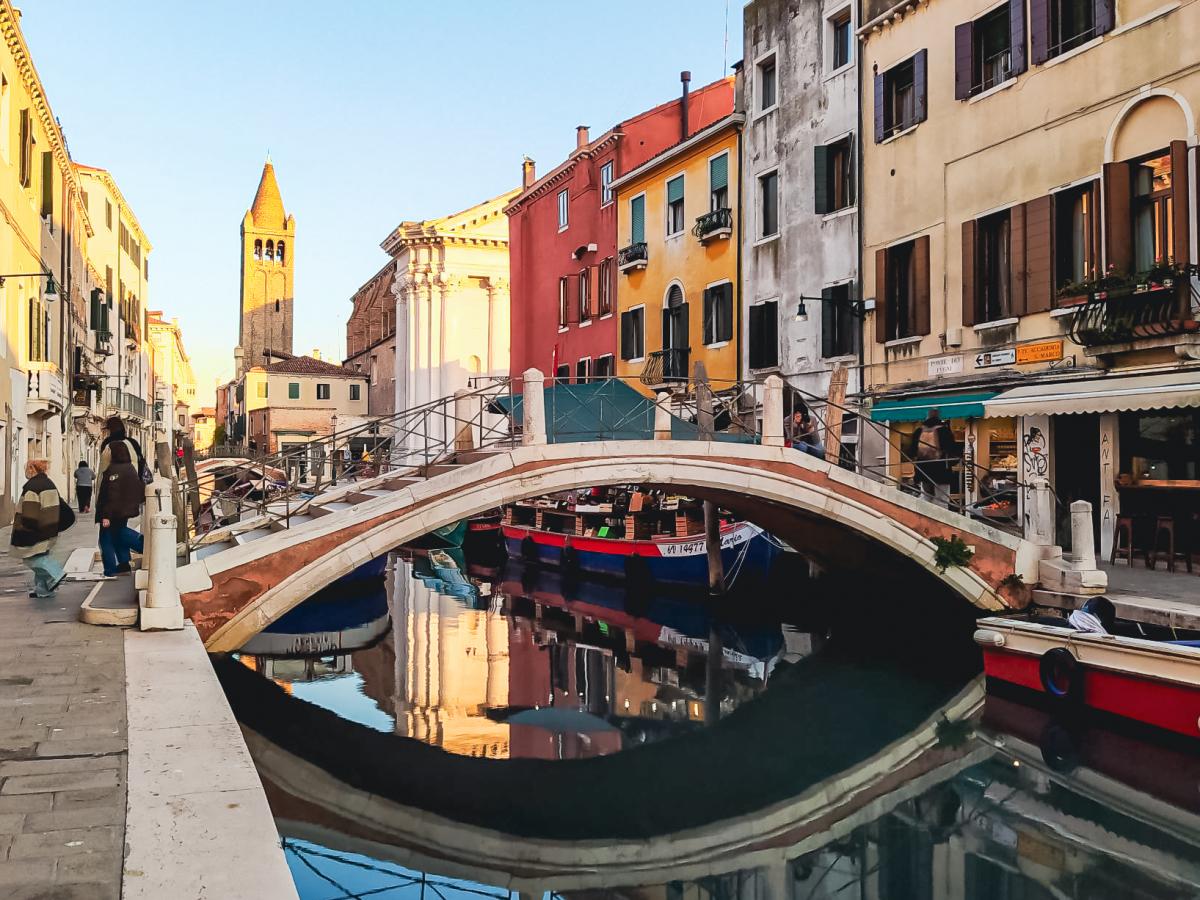
Ponte dei Pugni
Stage 4: Campo San Barnaba - Squero di San Trovaso
Continue by crossing through the Sotoportego Casin dei Nobili, then walk along Calle Lombardo and Fondamenta della Toletta until you reach Sacca della Toletta, home to a number of bars, pastry shops and a historic bookshop, where you might like to take a short break. When you reach the end of the calle, the recommended itinerary continues by turning right into Fondamenta Toffetti in the direction of the Ponte di San Trovaso, while going straight on and crossing the Ponte delle Maravegie will take you to the Ponte dell’Accademia.
After continuing right down Fondamenta Toffetti, you will come to Campo San Trovaso, home to the Church of Santi Gervasio e Protasio San Trovaso, also known as the San Trovaso, which cuts the urban space in two, interrupting its overall unity and creating two separate, independent areas. The church has two facades, each with its own entrance, and looks onto two different canals. The church interior houses important works, including canvases by Jacopo and Domenico Tintoretto and two altarpieces by Palma the Younger.
The part of the square facing Rio Ognissanti still has the characteristic quadrangular elevated section used to protect the central well from high waters. The large Renaissance well curb is still visible today, providing evidence of a complex system of collecting rainwater in cisterns that once extended down to five metres below the square.
In addition to the sixteenth-century well at the centre of Campo San Trovaso, there are also two other wells nearby. One is located next to the church and dates to the fifteenth century. It features a Gothic shield with the imperial double eagle, the emblem of the Giustianian family who built it. Meanwhile, the third and oldest well, dating to the fourteenth century, was the scene of a brutal murder in the eighteenth century. On 14 June 1779, a man’s torso was found inside the well, and within the space of a few hours other parts of his body were found in other wells and canals around the city. Investigations established that it was a crime of passion, one of the most famous in Venetian history, whose perpetrators were executed in Piazza San Marco.
Nearby is the Squero di San Trovaso boatyard. Although the entrance is in Campo San Trovaso, in order to admire it from the outside you need to go back and cross the Ponte di San Trovaso, then turn right into Fondamenta Nani, which looks onto the Rio di San Trovaso. Walking along the fondamenta (canal bank), you can see the seventeenth-century Squero di San Trovaso, one of the oldest gondola yards in the city (still in operation), on the right, on the other side of the canal, where typical lagoon boats such as gondolas, sandoli, sanpierote and caorline are repaired and built. According to some sources, the name “squero” derives from the word “squara” (square), used by carpenters to make boats. The city was once home to numerous squeri, until some of their business was absorbed by the naval industry of the Arsenale. One of the oldest crafts in the Venetian tradition is carried out in these boatyards.
The Squero di San Trovaso is spread across three buildings: two taller ones, with a house adjacent to them, and a lower one with a dock and boatshed. If you look closely at the structure of the squero, you will notice that it looks like a typical mountain house: the gallery on the upper floor is made entirely from wood, because the first owners of the squeri came from the Cadore area in the north, and were skilled woodworkers. Wood was an essential raw material for the Serenissima, used not only to build ships in the Arsenale and smaller boats in the squeri, but also to consolidate banks and foundations, for heating and for glassworks. The most valuable timber came from woods on the Venetian-Friulian plain and was transported to Venice on large rafts that travelled down the rivers:
• beech trunks from the Cansiglio Forest, nicknamed the “oar” forest, were used to make long oars for galleys;
• conifers came from Cadore, Vanoi or Primiero;
• firs from the Asiago Plateau reached Venice along the River Brenta;
• timber from the Vicenza plain arrived in Chioggia via the River Bacchiglione;
• wood from the Lessini mountains, the Verona area and the Tyrol reached the lagoon along the River Adige.
Useful information:
- Squero di San Trovaso: for private visits, booking is necessary at info@squerosantrovaso.com or at http://www.squerosantrovaso.com/n
- Church of San Trovaso or dei Santi Gervasio e Protasio: opening hours 8.00 a.m. –11.00 a.m.
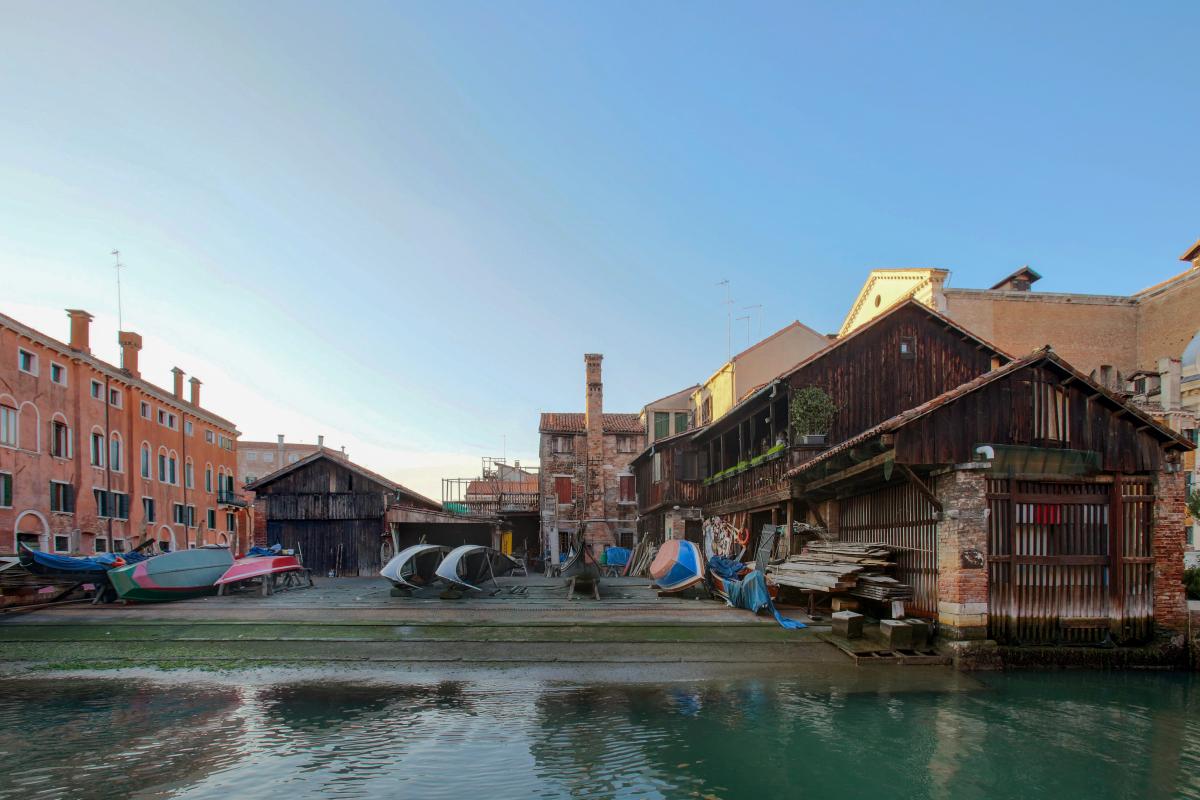
Squero di San Trovaso, one of the oldest gondola yards in the city
Stage 5: Fondamenta delle Zattere - Punta della Dogana
At the end of Fondamenta Nani, turn left and continue along Fondamenta delle Zattere, which offers a spectacular view of the Canale della Giudecca. Take a moment to breathe and enjoy the view of the islands of Giudecca and San Giorgio Maggiore. This long fondamenta (canal bank) extends from San Basilio, skirts the entire Giudecca Canal and ends at Punta della Dogana. Its name derives from the word “zattere” (rafts), because logs and timber transported along the rivers (loaded onto rafts) used to arrive here. Commonly known as “Zattere”, the fondamenta actually takes on different names: Fondamenta Molin, Fondamenta Zattere al Ponte Longo, Fondamenta Zattere ai Gesuati, Fondamenta Zattere agli Incurabili, Fondamenta Zattere allo Spirito Santo, Fondamenta Zattere ai Saloni, Fondamenta Zattere de la Dogana and Fondamenta Zattere de la Salute.
It is worth noting that if you take a boat here, you can link up with the “Beauty reflected in the water: discovering Giudecca and San Giorgio Maggiore” itinerary.
This area of the city is home to numerous places worth a visit, such as the Church of Santa Maria del Rosario or the Church of the Gesuati: an eighteenth-century building with a large number of frescoes, including the magnificent ceiling by Giambattista Tiepolo, on which you can admire three panels representing St Dominic Praying to the Virgin Surrounded by Saints, the Institution of the Rosary and the Glory of St Dominic. There is an interesting fact associated with this church, regarding the organs. There used to be two, as evidenced by the double choir loft. However, there is now only one Bazzani organ with a single keyboard and twenty-nine registers, dating back to 1856. In the past there was also a sixteenth-century organ, whose doors, painted by Titian, are now in New York.
The fondamenta is also home to the Accademia di Belle Arti (Academy of Fine Arts), while a little further on we come to the former Magazzini del Sale (Salt Warehouses). The bridge that precedes the Saloni, called the Ponte di Ca’ Balà, owes its name to the anagram of the word “Baccalà” (codfish): on the other side of the bridge we come to the old Magazzini del Sale, where numerous foods were stored, including codfish, a very common dish in Venice. The Magazzini del Sale were in a strategic location for the commercial traffic of the time, as the Zattere was one of the main landing points for boats. The Magazzini were used as a storehouse for salt, considered “white gold” by the Venetians, testifying to the power of trade in the Venetian economy of the past. The building is now owned by the City of Venice and various institutions are granted partial use of it, including:
• The Biennale, for free exhibitions and shows
• The Reale Società dei Canottieri Bucintoro 1882, which upholds the Venetian tradition of navigation with Venetian rowing, canoeing, lug sailing, rowing and even dragon boats.
• The complex also houses the headquarters of the Fondazione Emilio e Annabianca Vedova, with two exhibition spaces that host exhibitions, cultural initiatives and events dedicated to the works of the Venetian painter Emilio Vedova, together with the works of major international artists.
Once you reach the final stretch of Fondamenta delle Zattere, you will come to Punta della Dogana, one of the most scenic places in Venice, with a priceless view of the basin of San Marco and the lagoon. As the name reminds us, from as early as the start of the fifteenth century, the customs house was the place where goods arriving by sea were taxed. Today it houses a series of contemporary art exhibitions managed by the Fondazione Pinault, with access from Campo della Salute.
Useful information:
- Church of Santa Maria del Rosario: Monday to Saturday 10.30 a.m. – 1.30 p.m. and 2.30 p.m. – 5.00 p.m. Admission €3. https://www.chorusvenezia.org/
- Fondazione Vedova: visit the website for information on current exhibitions https://www.fondazionevedova.org/
- Reale Società dei Canottieri Bucintoro 1882: https://www.bucintoro.org/
- Punta della Dogana: open every day from 10.00 a.m. – 7.00 p.m. Closed on Tuesdays. Check the website for current exhibitions. https://www.palazzograssi.it/it/about/spazi/punta-della-dogana/
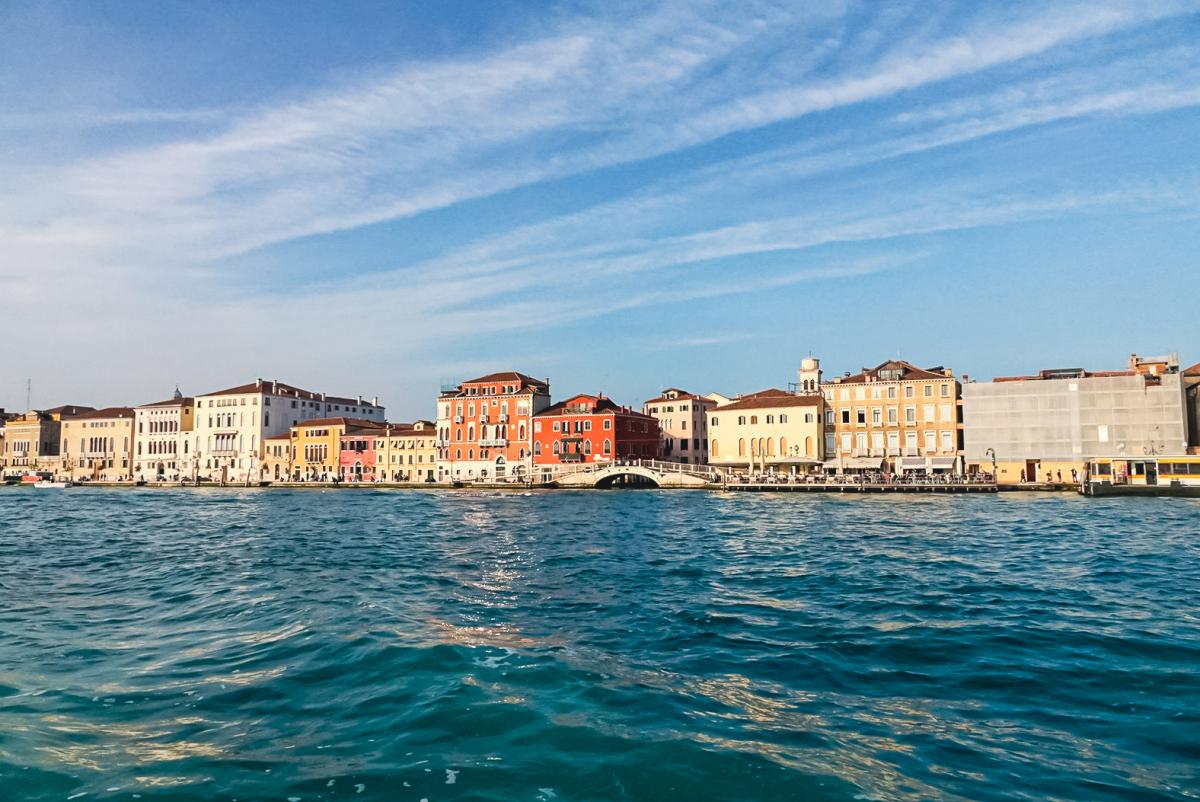
Fondamenta delle Zattere
Stage 6: Basilica of the Madonna della Salute - Peggy Guggenheim
The itinerary continues towards the Canal Grande along Fondamenta della Dogana to Campo della Salute, where you can admire the majestic Basilica of the Madonna della Salute, a masterpiece by Baldassarre Longhena. The basilica has an interesting history: on 22 October 1630, after the plague spread through the city, the doge and the senate of the Serenissima vowed to erect a church that was “magnificent and lavish”, dedicated to the Blessed Virgin and named Santa Maria della Salute.
A competition was announced for the construction of the church and eleven designs were submitted. The winner was the design by Longhena, characterised by its original proposal for a religious building with a central plan, raised above the foundations by an imposing flight of steps, so as to further enhance the senate’s choice of location for the church. Indeed, the site chosen for the construction of the church, seen from Piazzetta San Marco, benefits from a sweeping perspective that embraces the entire basin of San Marco, incorporating the buildings comprising the seat of the Venetian government, the island of San Giorgio, the Canale della Giudecca and the Canal Grande.
The first stone was laid in 1631 and the church was consecrated in 1687, five years after Longhena’s death. By 1681, the feast of the Madonna della Salute had been introduced. One of the feast days dearest to the hearts of the Venetians, it is still celebrated every 21 November, the day of the Presentation of the Blessed Virgin Mary.
The sumptuous Istrian stone facade is decorated with pilasters, niches, tympanums, statues and a magnificent portal in the middle. The building is characterised by its double dome. The lantern is topped with a statue of the Virgin in the guise of “Capitana da mar”, flanked by other statues. The building has volute buttresses on the outside, and extends to the south with the smaller chancel with side apses, covered in turn by a lower dome and flanked by two bell towers.
The interior is bright and monumental. The central body of the church has an octagonal plan, with six chapels lining the ambulatory. The grandiose high altar, designed by Baldassarre Longhena and made by Josse Le Court, shows the city of Venice kneeling before the Madonna and Child and asking for protection from the plague, with the latter personified by an old woman fleeing the scene with raised arms. The altar surrounds the venerated Greek-Byzantine icon of the Virgin Mesopanditissa, transferred here from Candia in 1672. The third altar on the left features Titian’s Pentecost. There are also other works by the great artist in the sacristy, together with others by Tintoretto, not forgetting the many masterpieces by minor artists.
Inside the Basilica, you can admire works by artists such as Luca Giordano and Jacopo Palma the Younger, as well as sculptures by Gian Maria Morlaiter and reliefs by Bartolomeo Bon and Tullio Lombardo. The main sacristy is a real treasure chest, housing twelve works by Titian, a Tintoretto and an extensive series of works of great beauty, albeit by minor artists.
The choir, located behind the altar, is a very fine piece of wooden sculpture, probably designed by Baldassarre Longhena between 1679 and 1681. Above the choir is the choir loft with the organ built by Francesco Dacci Jr. in 1782 and then modified by Bazzani in the early nineteenth century.
On the occasion of the feast of the Madonna della Salute, a long procession used to leave San Marco and make its way to Santa Maria della Salute via a bridge of boats that spanned the Canal Grande. To this day, a votive bridge is set up across the Canal Grande to allow pilgrims to reach the basilica on foot.
The itinerary continues through a very distinctive area of Dorsoduro, dotted with art galleries, local craft shops, jewellery shops, collectors and a number of glassmakers. Once you have visited the basilica, leave the church behind you and follow Fondamenta della Salute, crossing the Ponte de l’Abazia and making your way to Campo San Gregorio, where you will find the deconsecrated abbey of San Gregorio, founded in 1160 by the Benedictines of Sant’Ilario. From here, go straight down Calle Bastion and, as soon as you cross the Ponte di San Gregorio, turn left into Fondamenta Soranzo. Here we recommend visiting a traditional oar maker's workshop, where one of Venice's remèri make the rowlocks and oars used in local boats. This ancient craft has become an art today: the rowlock has become a designer object that is even exhibited at the MoMA in New York.
To continue the itinerary, go back to the bridge and turn left into Calle Bastion, then continue straight on until you come to Campiello Barbaro, a very special space that stands out for its small flower garden in the centre. On the right, before the Ponte San Cristoforo, you can see the back of Palazzo Dario, a Gothic residence renovated in 1487. The main facade, overlooking the Canal Grande, features a rich, vibrant decoration in polychrome marble.
Cross the Ponte San Cristoforo, one of the city’s oldest bridges with semi-circular steps, and walk along Fondamenta Venier dai Leoni. It was here, in Palazzo Venier dei Leoni, that the American collector Peggy Guggenheim lived. Today the palace houses her precious art collection and has become one of Italy’s most important museums of twentieth-century European and American art.
The Venier family commissioned the architect Lorenzo Boschetti (who also designed the Church of San Barnaba in Venice) to build Palazzo Venier dei Leoni in 1749. The facade was intended to rival that of Palazzo Corner opposite, but historical events involving the family and the city meant that the building remained unfinished. Although a lion is said to have been kept in the garden, it seems more likely that the building’s name derives from the Istrian stone lion heads that embellish the facade at water level.
If you decide to visit the museum, you will be able to admire the adjoining garden, conceived as an exhibition venue for a number of works from the museum’s permanent collection, as well as sculptures from other foundations and galleries. Recently, following a long period of study and preservation work, Opera 3, a glass sculpture created by Egidio Costantini, a friend of Peggy’s, in partnership with the Japanese architect Omura between 1968 and 1969, has returned to the museum’s sculpture garden.
Keen cinemagoers will be interested to note that a number of scenes in the 2010 film The Tourist, starring Johnny Depp and Angelina Jolie, were filmed near the Peggy Guggenheim Collection.
Useful information:
- Basilica of the Madonna della Salute: free entry to the basilica. Tickets for the Sacrestia Maggiore Museo cost €4. https://basilicasalutevenezia.it/
- Peggy Guggenheim Collection: open daily 10.00 a.m. – 6.00 p.m. Closed on Tuesdays. Full-price ticket €15. See website for full price list https://www.guggenheim-venice.it/it/
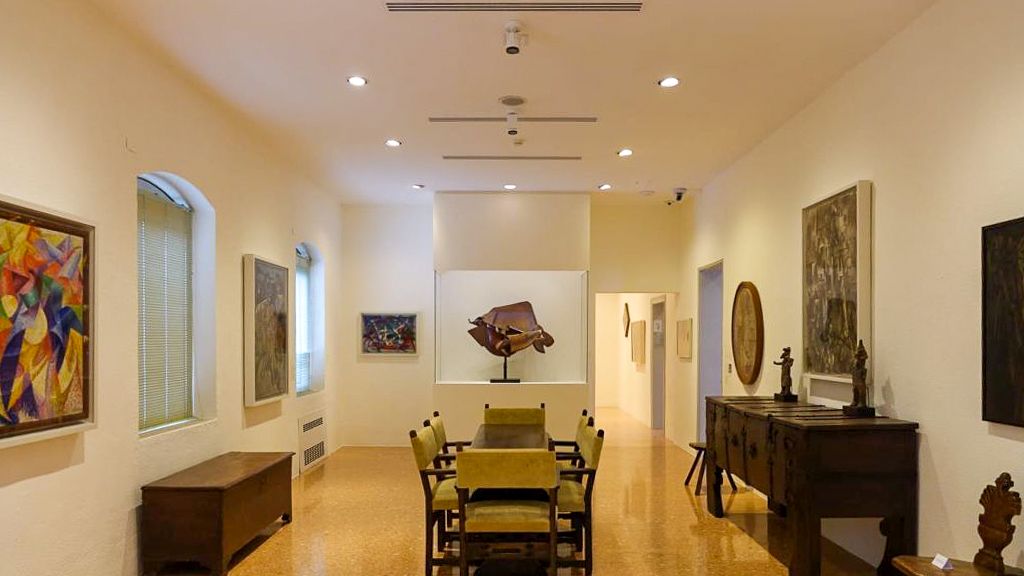
The Peggy Guggenheim Collection, one of the world’s most important contemporary art museums
Stage 7: Peggy Guggenheim - Ponte dell’Accademia - Gallerie dell’Accademia
From Fondamenta Venier dai Leoni, continue along Calle della Chiesa and cross Campo San Vio. After crossing the bridge of the same name, you will see the extraordinary home-museum of Palazzo Cini on the right, which houses a precious selection of the antique art collection of Vittorio Cini, one of the most important collectors in twentieth-century Italy.
Continue along Calle Piscina dei Forner and Calle Nova Sant’Agnese, then turn right in the direction of the Ponte dell’Accademia. You will come to Campo della Carità, at the foot of the majestic Ponte dell’Accademia, with the galleries of the same name adjacent to it. The wooden bridge was built in just one month, between 1932 and 1933, to replace the previous iron bridge opened in 1854. The wooden structure was always intended to be temporary and was to be replaced by a stone bridge a few years later, but over time it became permanent. You can enjoy one of the most beautiful views of the Canal Grande from the top.
We recommend a visit to the Gallerie dell’Accademia, a state museum boasting important collections of art from Venice and the Veneto region, mainly comprising paintings dating from the thirteenth to the nineteenth century, housed in twenty-nine rooms. The works on display comprise both the original collections and works from suppressed places of worship, private donations and legacies that have gradually been added to them.
At one time the galleries were a large convent complex formed by the Church of Santa Maria della Carità, the convent of the Canonici Lateranensi and the Scuola Grande di Santa Maria della Carità, the oldest in the city, built in 1206 and also known as the Scuola Grande dei Battuti.
The galleries house some real treasures, such as the cycle of canvases with the Miracles of the Cross by Gentile Bellini and his school, the cycle with the Stories from the Life of St Mark by the school of Bellini, and the cycle of St Ursula by Vittore Carpaccio.
Also on display are Giovanni Bellini’s San Giobbe Altarpiece, Giorgione’s Old Woman and The Tempest, Lorenzo Lotto’s Portrait of a Gentleman, Andrea Mantegna’s St George, and Piero della Francesca’s St Jerome and a Devotee.
You can also admire masterpieces by Paolo Veronese, such as the enormous Feast in the House of Levi, as well as canvases by Jacopo Tintoretto: The Abduction of the Body of St Mark, the Miracle of the Slave and St Mark Saving a Saracen from Shipwreck.
There are also works by Titian, including the Presentation of the Virgin at the Temple and the Pietà that was his last work.
The bookshop at the entrance to the museum was renovated in autumn 2019. The Gabinetto dei Disegni e delle Stampe at the Gallerie dell'Accademia possesses some of the most important folios pertaining to Western culture, including Leonardo da Vinci’s Vitruvian Man, which is rarely exhibited, in order to preserve it.
Useful information:
- Palazzo Cini: https://www.palazzocini.it/en/
- Gallerie dell’Accademia: Full-price ticket €12. Check the website for updated opening hours https://www.gallerieaccademia.it/
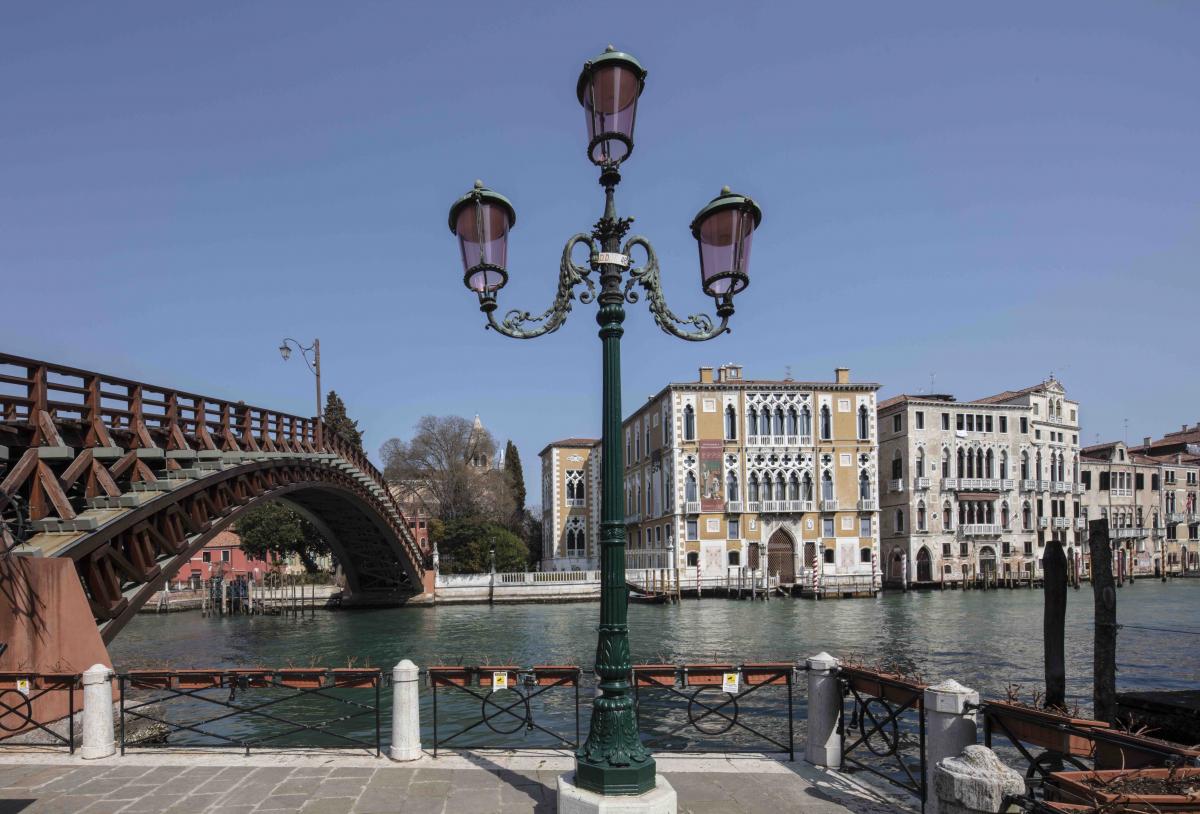
Ponte dell’Accademia, from the top of which you can enjoy one of the most beautiful views of the Canal Grande
Arrival: Campo Santo Stefano – Campo San Samuele - Gran Teatro La Fenice
After crossing the Ponte dell’Accademia and Campo San Vidal, where the Church of San Vidal is located, you will come to Campo Santo Stefano, one of the largest squares in the city. Here you will see two large wells and a statue dedicated to Niccolò Tommaseo, an exponent of nineteenth-century Italian culture. Palazzo Loredan, seat of the Istituto Veneto di Scienze, Lettere ed Arti (Veneto Institute of Science, Literature and Art) looks onto this square. The ground floor of the building houses a collection of marble busts of some of the most significant figures in the history of the city, including Titian, Veronese, Palladio, Dante Alighieri and many others. At the far end of the square, on the south side, is the Church of Santo Stefano, one of the most important Gothic religious buildings.
Near the entrance to the square, if you turn right, you will come to Campiello Pisani, home to Palazzo Pisani, the most imposing patrician palace in the city, second in size only to Palazzo Ducale (Doge’s Palace). Since 1897 it has housed the Conservatorio di Musica Benedetto Marcello, named after the composer Benedetto Marcello, born in Venice on 24 July 1686. The library is particularly noteworthy, numbering among the richest to be found in any Italian conservatory: it houses more than 60,000 volumes, including autograph manuscripts by Vivaldi, Liszt and even Marcello himself.
In the 2006 film Casino Royale, starring actor Daniel Craig as secret agent James Bond, this building collapses following a shootout inside.
Crossing Campo Santo Stefano, at the church of the same name, enter Calle delle Botteghe on your left. The entire area between Calle delle Botteghe and Campo San Samuele is a succession of art galleries, design studios, local and Italian craft shops and modern antique shops. Continue right along Calle delle Botteghe and Calle Crosera until you come to an arch between two houses. Immediately on the right, in Ramo della Piscina, you will find the historical archive of the long-established Rubelli weaving mill, renowned since 1889 for the production of passemanterie, counter-cut velvets, handmade velvets, lampas and brocades. Ca’ Pisani Rubelli, which can be visited by appointment, contains over 6000 textile documents dating from the end of the fifteenth century to the first half of the twentieth century, and also includes the precious silk velvets made for the Royal House of Savoy in the early twentieth century.
If you continue along Salizada San Samuele, at number 3338, on your right, you will see the plaque that commemorates the Venetian home of Paolo Veronese, where the artist died on 19 April 1588. Continue straight ahead down Calle de le Carrozze until you reach Campo San Samuele, where you can take a break on a bench overlooking the Canal Grande. From here you can visit Palazzo Grassi, which hosts contemporary art exhibitions from the Pinault collection, one of the largest private collections in the world.
Just a few minutes walk from Campo San Samuele is the Gran Teatro la Fenice, one of the most prestigious opera houses in the world. Return towards Campo Santo Stefano, enter Campiello Santo Stefano and continue straight on until you reach Campo Sant'Anzolo. From here, turn right along Calle del Cafetier towards Campo San Fantin, where you will see the opera house on your right, designed in 1789 and inaugurated on 16 May 1792, and today known as the Theatre of Venice. The guided tour of the theatre, exploring the prestigious stucco work and gold interiors, allows you to discover the background and secrets of La Fenice and its people, tracing its history from its origins to the present day. The theatre also hosts a permanent exhibition dedicated to Maria Callas and her years of activity in Venice.
This is the end of the itinerary. From here, you can decide to link up with the “Monumental Churches, Synagogues and scuole grandi: a multicultural walk in Cannaregio” itinerary, or visit other nearby points of interest in the city such as Rialto or San Marco, following the numerous yellow signs.
Useful information:
- Istituto Veneto di Scienze, Lettere ed Arti: http://www.istitutoveneto.it/flex/cm/pages/ServeBLOB.php/L/IT/IDPagina/1
- Conservatorio di Musica benedetto Marcello: https://www.veniceontop.com/en/
- Palazzo Grassi: https://www.palazzograssi.it/it/
- Gran Teatro La Fenice https://www.teatrolafenice.it/
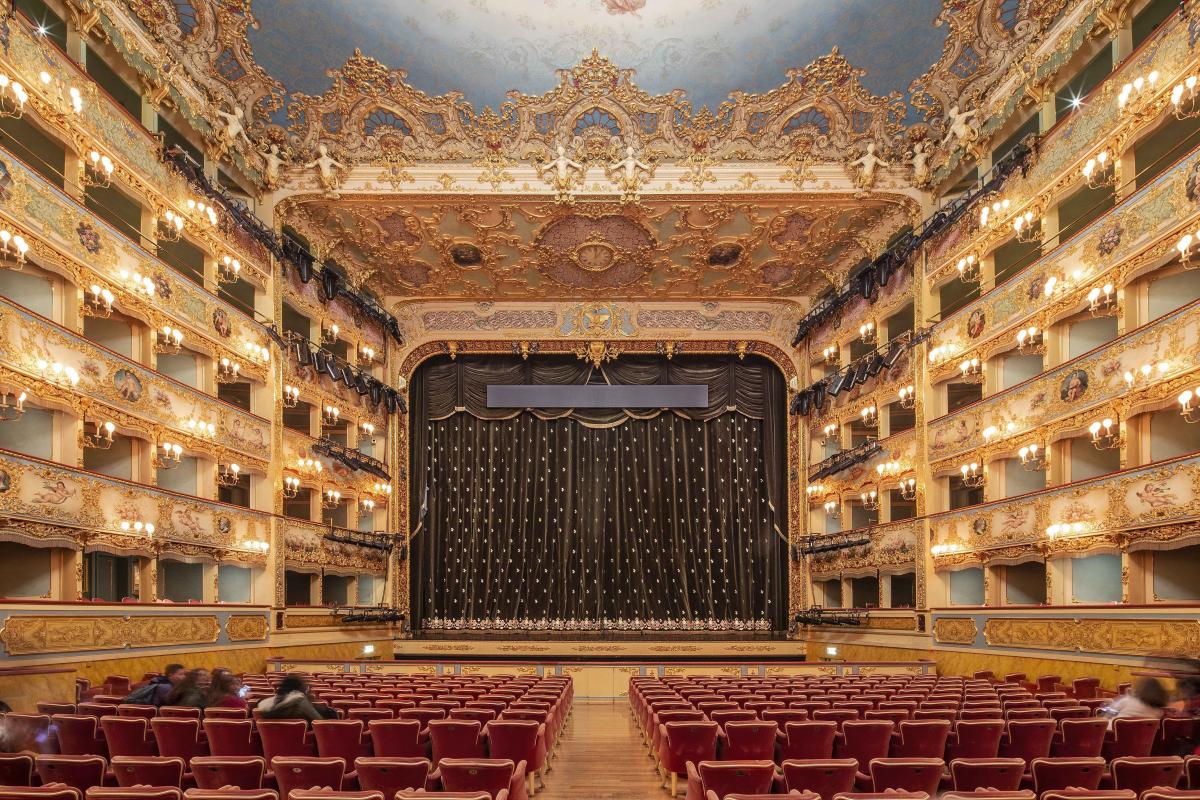
Gran Teatro La Fenice
Sources
-
Guida Rossa Touring Club Italiano. 2005. Venezia. La biblioteca di Repubblica
-
Giulio Lorenzetti – Venezia e il suo estuario, 1974
-
1999. Calli, Campielli e Canali – Guida di Venezia e delle sue isole. Edizione Helvetia
-
Marina Crivellari Bizio. 2009. Campi Veneziani – Storia e segreti dei campi veneziani. Filippo Editore Venezia
-
Mariagrazia Dammicco. 2013. Guida ai Giardini Veneziani. La Toletta Edizioni.
-
Visite guidate e non in alcuni punti di interesse tra i quali chiese, musei, mostre e botteghe di artigianato etc.
-
Itinerari Veneziani, Marsilio



